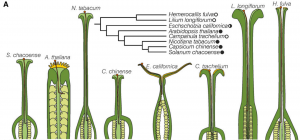To reach the female gametophyte, growing pollen tubes must penetrate different tissues within the pistil, the female
reproductive organ of a flower. Past research has identified various chemotropic cues that guide pollen tubes through the
transmitting tract of the pistil, which represents the longest segment of its growth path. In addition, physical mechanisms also
play a role in pollen tube guidance; however, these processes remain poorly understood. Here we show that pollen tubes from
plants with solid transmitting tracts actively respond to the stiffness of the environment. We found that pollen tubes from
Nicotiana tabacum and other plant species with a solid or semisolid transmitting tract increase their growth rate in response to an
increasing matrix stiffness. By contrast, pollen tubes from Lilium longiflorum and other plant species with a hollow transmitting
tract decrease their growth rate with increasing matrix stiffness, even though the forces needed to maintain a constant growth
rate remain far below the maximum penetration force these pollen tubes are able to generate. Moreover, when confronted with a
transition from a softer to a stiffer matrix, pollen tubes from N. tabacum display a greater ability to penetrate into a stiffer matrix
compared with pollen tubes from L. longiflorum, even though the maximum force generated by pollen tubes from N. tabacum (11
mN) is smaller than the maximum force generated by pollen tubes from L. longiflorum (36 mN). These findings demonstrate a
mechano-sensitive growth behavior, termed here durotropic growth, that is only expressed in pollen tubes from plants with a
solid or semisolid transmitting tract and thus may contribute to an effective pollen tube guidance within the pistil.
Read the full article in Plant Physiology as well as this news article by Emily R. Larson.


